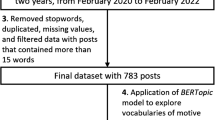Abstract
A content analysis of women profiled in women's magazines asked, How do “established” vs. “new” magazines differ in socialization messages about work options for women? Six established and four new magazines were analyzed from 1971 through 1980, for a total random sample of 232 issues (172 individual profiles). Three hypotheses were investigated. Compared to new magazines, established magazines are (1) less likely to present women in a variety of work roles and (2) more likely to profile women in “traditional” occupations. (3) Employed women profiled in established magazines are less likely to perceive themselves as having responsibility and/or power/influence in relation to their jobs. Hypotheses 2 and 3 were supported. The discussion highlights changes in both types of magazines but notes the fairly traditional message established magazines present vs. new magazines.
Similar content being viewed by others
References
Clarke, P., & Esposito, V. A study of occupational advice for women in magazines. Journalism Quarterly, 1966, 43, 477–485.
Dominick, J. R. The portrayal of women in prime time, 1953–1977. Sex Roles, 1979, 5, 405–411.
Flora, C. B. The passive female: Her comparative image by class and culture in women's magazine fiction. Journal of Marriage and Family, 1971, 33, 435–444.
Franzwa, H. H. Women working in fact and fiction. Journal of Communication, 1974, 24, 104–109.
Franzwa, H. H. Female roles in women's magazine fiction, 1940–1970. In R. K. Unger & F. L. Denmark (Eds.), Woman: Dependent or independent variable. New York: Psychological Dimensions, 1975, pp. 42–53.
Hatch, M. G., & Hatch, D. L. Problems of married working women as presented by three popular working women's magazines. Social Forces, 1958, 37, 148–153.
Leading Edge. Traditional magazines reflect changing roles, values of women. Leading Edge: A Bulletin of Social Transformation, September 8, 1980, 1, 4.
Phillips, E. B. Magazines' heroines: Is Ms. just another member of the family circle? in G. Tuchman, A. K. Daniels, & J. Benet (Eds.), Hearth and home: Images of women in the mass media. New York: Oxford University Press, 1978, pp. 116–129.
Smith, M. Y. Research retrospective: Feminism and the media. Communication Research, 1982, 9, 145–160.
Tuchman, G. Introduction: The symbolic annihilation of women by the mass media. In G. Tuchman, A. K. Daniels, & J. Benet (Eds.), Hearth and home: Images of women in the mass media. New York: Oxford University Press, 1978, pp. 3–38.
Author information
Authors and Affiliations
Rights and permissions
About this article
Cite this article
Ruggiero, J.A., Weston, L.C. Work options for women in women's magazines: The medium and the message. Sex Roles 12, 535–547 (1985). https://doi.org/10.1007/BF00288174
Issue Date:
DOI: https://doi.org/10.1007/BF00288174




